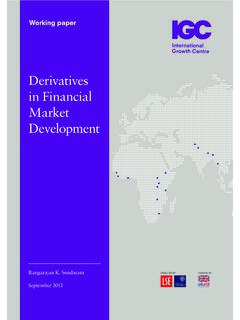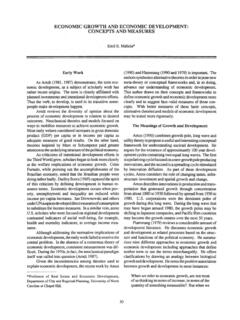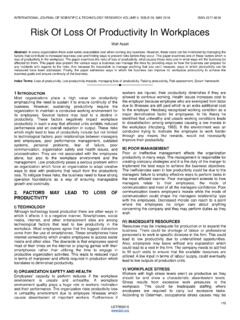Transcription of Technical and Vocational Education and Training
1 Working paperTechnical and Vocational Education and Training in EthiopiaPramila Krishnan Irina Shaorshadze February 2013 1 Technical and Vocational Education and Training in Ethiopia Paper for the International Growth Centre Ethiopia Country Programme Irina Shaorshadze and Pramila Krishnan1 December 2012 Abstract This report presents a background study of the state of Technical and Vocational Education and Training in Ethiopia. We discuss the state of TVET in Ethiopia, as well as the contextual information on Education system and economic indicators in Ethiopia as they relate to the TVET implementation and policy. We argue that given the supply-driven nature of the TVET system in Ethiopia, it is important to improve its efficiency, and we propose two ways to doing this: (1) Improve efficiency and equity of the centrally-driven allocation mechanism drawing on the recent advances in matching algorithms and their application to the school choice; (2) Impact evaluation of the final labour market outcomes of the graduates has to be integral part of the TVET system, and we discuss various ways such evaluation could be conducted.
2 1 We would like to thank Ibrahim Worku and Alebel Bayrau Weldesilassie for the help gathering the data and information on TVET during our visit to Addis Ababa. 2 Abbreviations and Acronyms CSA Central Statistical Authority EDRI Ethiopian Development Research Institute GDP Gross Domestic Product GER Gross Enrolment Rate ICA Investment Climate Assessment LSMS Living Standards Measurement Survey MOE Ministry of Education NEAEA National Educational Assessment and Examination Agency NER Net Enrolment Rate NGO Non-Governmental Organization NLA National Learning Assessment SSA Sub-Saharan Africa RemSEDA Regional Medium and Small Enterprise Development Agency TFP Total Factor productivity TVET Technical and Vocational Education and Training VET Vocational Education and Training 3 Contents Abbreviations and Acronyms.
3 2 1. Executive Summary .. 5 2. Introduction and the Contextual Background .. 6 TVET Policy and it Evaluation 6 TVET Policy and the Development Community Agenda .. 6 German-Style Apprenticeship-based TVET system .. 6 TVET in Sab-Saharan Africa .. 7 Lessons from TVET Evaluations .. 8 Ethiopia: The Socio-Economic Context .. 10 Economic Indicators in Ethiopia .. 10 Education System in Ethiopia .. 12 3. TVET in Ethiopia .. 13 TVET System in Ethiopia: Statistics .. 13 National Exam Determining Access to the TVET Track .. 15 TVET Fields of Study .. 17 Apprenticeship/Job Training .. 18 Skill Competency Assessment .. 18 Qualifying TVET Instructors .. 19 4. Lessons from the Efficient Mechanism Design Literature .. 19 5. TVET Impact Policy Evaluation.
4 21 Existing Data and Tracer Studies .. 21 Evaluation Problem: Looking for the Counterfactual .. 22 Designing the Impact Evaluation Study .. 22 Impact Evaluation Design Options .. 22 Labour Market Indicators of Interest .. 24 Evaluation Issues .. 25 General Equilibrium Effects .. 25 Displacement Effects .. 26 6. Summary .. 26 References .. 27 Appendix .. 29 4 5 1. Executive Summary This report presents a background study of the state of Technical and Vocational Education and Training (TVET) in Ethiopia. The aim of the report is threefold: (1) To summarize the current state of affairs on TVET in Ethiopia in order to present the contextual information for the researchers and the donor community; (2) To inform policymakers in Ethiopia on the best practices related to the impact evaluation of the TVET in terms of the final labour market outcomes of its participants, as well as on best practices on efficient design of school-choice matching mechanisms; (3) To discuss options for designing and conducting TVET impact evaluation in Ethiopia.
5 The TVET system in Ethiopia is currently rapidly expanding. The government believes that the present low factor productivity is due to the skill gap, and that left to its own, the industry will provide less Training than is socially optimal. Therefore, publicly provided Vocational Education is seen by the government as the means to close this skill gap. The government of Ethiopia looks at the public TVET as the key in improving the productivity of the enterprises and increasing their competitiveness in the global market. Government involvement goes beyond mere provision of TVET. The Ministry of Education administers the centralized exam at the end of the primary school, and scores on this exam determine if a student continues to the preparatory school or is placed in the TVET track.
6 This national exam also determines which level of the TVET the individual can join. Furthermore, the allocation of the numbers of places for specialization is also centrally determined. In this regard, TVET system in Ethiopia is essentially command driven, even though the government recognizes the importance of ensuring the system is sufficiently flexible and responsive to demands of industry. Even if the arguments for centrally directed TVET were convincing, ensuring that such a non-market based system improves the outcomes of its beneficiaries is challenging in practice. We take as given the supply-driven nature of the TVET in Ethiopia. We argue that the supply-driven nature to TVET calls for mechanisms that would improve its efficiency and evaluate its effectiveness.
7 We identify two areas for improvement: (1) Making the current student allocation mechanism more efficient, equitable and strategy-proof, guided by recent advances in school choice algorithms. (2) Conducting impact evaluation of the TVET Training on the final labour market outcomes of the beneficiaries. Such evaluations should go beyond the tracer studies that look at the outcomes of the graduates of particular institutions, and should attempt to answer questions of the nature: what would be the outcomes of the TVET graduates relative to the counterfactual of no having gone through the TVET. Getting to such counterfactual is challenging, and we will outline a few ways that such studies can be conducted. The rest of the report is structured as follows: Section 2 presents the contextual information on the TVET systems internationally and in Sub-Saharan Africa (SSA).
8 It also gives the relevant socioeconomic background on Ethiopia. Section 3 describes the TVET in Ethiopia in detail; and Section 4 presents the relevance of the recent literature on the efficient school choice algorithms for improving efficiency and equity in the TVET of Ethiopia. Section 5 discusses the design options for the TVET impact evaluation. Section 6 concludes. 6 2. Introduction and the Contextual Background TVET Policy and it Evaluation Practices TVET Policy and the Development Community Agenda Technical and Vocational Education and Training (TVET) provides trainees with the Technical skills applicable for the particular trade. In practice, different types of programmes are included under the umbrella of TVET.
9 Grubb and Ryan (1999) distinguish the following four types of programmes. (1) Pre-employment VET prepares individuals for the initial entry into the employment. The regular track of the TVET in Ethiopia falls under this category. (2) Upgrade Training provides additional Training for the employed individuals; (3) Retraining provides the Training for individuals that have lost jobs or for those wishing to switch careers; (4) Remedial VET provides Training to individuals out of the mainstream labour force. During the last couple decades, the World Bank's advice to developing countries seems to have been that basic Education should be the top priority, and that public expenditure on VET should be reduced (Bennell & Segerstrom, 1998).
10 Such advice is based on the proposition that provision and funding of VET is best left to the individuals, private enterprises and private institutions. This is justified by the fact that the demand-driven Training systems have outperformed supply-driven systems. During the last couple decades, the interest in TVET was also low within the donor community, partly as a result of the increased focus towards the sectorial work. By its nature TVET is multi-sectoral and it was relatively neglected as a result. However, TVET has recently returned to the international development policy agenda. The discourse on TVET has been reinvigorated under the following three themes. (1) During the last decade, the issue of TVET has been linked to the topics such as the Millennium Development Goals.










